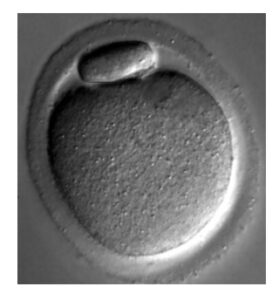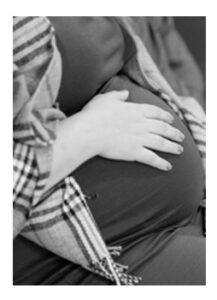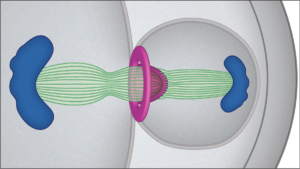Research

A healthy egg is essential for a successful pregnancy and full-term development. The chromosome content of the egg and sperm is an exquisitely important characteristic: a single extra or missing chromosome in the embryo typically leads to arrested development and miscarriage (i.e., pregnancy loss). Such numerical chromosomal abnormalities, termed “aneuploidies,” are most often found in the egg; approximately 10-25% of eggs in reproductive-age individuals are aneuploid and are the leading genetic cause of early miscarriage. Research in the Schindler lab aims to understand the molecular and genetic control of meiotic chromosome segregation, egg quality and how these events are connected with reproductive life span. We have several different research themes that tackle these biological inquiries.
1. Determine how Aurora protein kinases control chromosome segregation and egg quality. Meiotic chromosome segregation is essential for nearly all species to survive. In humans, errors in meiosis I (MI) are highly linked to miscarriages and developmental disorders. Therefore, meiotic chromosome segregation must occur with high fidelity to ensure genome integrity and offspring survival. Yet, chromosome segregation error rates in women are astonishingly high, affecting ~20% of ovulated eggs in reproductively young women (early 20’s) and ~100% in reproductively older (40+y) women. The mechanistic bases for high chromosome error rates are not fully understood and is a key gap in our knowledge because we do not have a comprehensive understanding of how good eggs form.
A major focus of the Schindler lab’s research is studying Aurora kinase (AURK) functions in mammalian oocytes. AURKs are essential, multifunctional chromosome segregation regulators. Most eukaryotes encode two Aurk homologs, Aurka and Aurkb, that are expressed in all cells. Mammals encode a gamete-specific third homolog, Aurkc. By creating unique strains of mice that lack each Aurora kinase in their oocytes, we have discovered the requirements for each AURK in mouse oocytes and have established that they regulate one another. By combining mouse genetics and high resolution microscopy, we established that AURKA is not only necessary and sufficient for proper spindle assembly in oocyte meiosis, but that it performs multiple additional functions critical for egg quality. Our current research aims to fully understand how AURKA contributes to egg quality and how the kinases regulate cytokinesis, the final step in making a functional egg
2. Identify human genetic variants associated with elevated egg aneuploidy. Infertility affects 1 in 6 couples in the United States and is a growing public health concern. Aneuploidy, having one or more missing or extra chromosomes, is the most common genetic abnormality in preimplantation embryos often causing early miscarriage and fertility treatment failure. Most embryonic aneuploidies originate from meiotic errors in female gametes (eggs). Although maternal age is associated with increasing risk of egg aneuploidy, there is a large variation in the prevalence of aneuploidy in eggs from women of the same age. We aim to understand the genes and pathways that are involved in human female meiosis, and to identify biomarkers in females that can predict risk of producing an aneuploid conception. To do this, we work a team of investigators with extensive expertise in complementary fields: computational and statistical genetics; worm, fly, and mouse genetics; and human reproduction and genetics.
3. Understand why Sirtuin 7 is required for reproductive longevity. Reproductive aging has profound impacts on women’s health, affecting hormone production, fertility, quality of life and longevity. In many western societies, it is becoming more common for women to embark on family building in their 30’s, a decade where reproductive decline has already started. In the US, birth rates to women 30 years and older increased 5% in 2021. To develop clinical diagnostics or interventions to assist patients embarking on parenthood at older ages and to improve healthy life span for women approaching and in menopause, it is essential to first advance our understanding of the basic mechanisms that cause reproductive aging. Sirtuins are a family of protein deacetylases that play key roles protecting genome integrity and responding to age-related stresses. One member of the sirtuin family, SIRT7, is of particular interest in female reproductive aging biology because our studies show that SIRT7 is crucial for establishment of the number of oocytes in ovaries (i.e. ovarian reserve) in mouse. Therefore, SIRT7 is required for establishing the reproductive lifespan. Our current studies aim to determine if there is an age-dependent requirement for SIRT7 in ensuring egg quality.
4. Determine contents and fate of meiotic midbodies. In all cells undergoing cytokinesis, a membraneless organelle called a midbody (MB) forms between the dividing cells. MBs are ribonucleoprotein granule assembly sites, enriched in mRNAs that encode cell fate, oncogenesis and pluripotency proteins and are sites of localized translation. Materials stored in eggs are required and used after fertilization to support healthy embryo development, but the identity of these materials and how the embryo inherits them are not fully understood. During the last step in egg formation a structure called a meiotic midbody forms, and this newly identified structure contains dormant and actively translated mRNAs. We aim to identify the contents of these midbodies, determine their fate and explore how midbodies form and are regulated.




